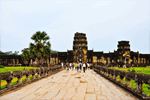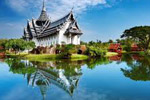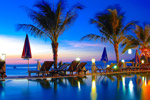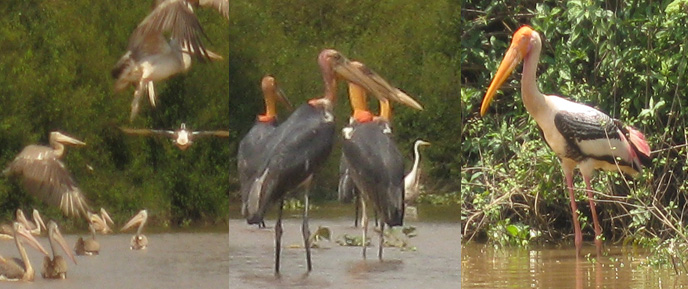|
|
Laos Place of Interest
This section covers many valuable resources on Laos such as the travel guides or tips to travelers. Some of the topics contain links to the other related sites of similar subjects. In certain topic, we include lists of useful contacting address for your information.
STATISTICAL FACTS ABOUT LAOSINTRODUCTIONS TRAVEL TIPS+ Climate and Clothing - Light-weight washable cotton or cotton-blent clothes are suitable. A sweater or coat is needed for the winter and in upland areas. + Customs and Immigration - A valid transit, tourist visit, business, diplomatic, or service visa is required. All foreigners may enter and depart Laos via Wattay Airport, or Thai-Lao Friendship Bridge, the Mekong border crossing with Nongkai, Thailand. A visa can now be obtained upon arrival at the airport and other official entry points. However, certain regulations are applied. + Health - Medical and dental facilities are mostly operated by the government. Private clinics and pharmacies are available in the major cities. The International Clinic is operated under the supervision of the Ministry of Health, to accommodate foreigners and diplomats. Medicines from France, USA, Russia, Thailand and China are widely available in most pharmacies. + Telecommunications - International telephone, fax, telegraph and telex services are available at post offices, hotels and business centers. Mobile phones are widely used. Several radio stations broadcast in Lao. The Lao National Radio carries news in English, French and Thai. There are daily TV broadcasts, with two local channels, Thai television and satellite reception. + Transportation - Public transportation is by bus, taxi and samlo (rickshaw). There are both metered and unmetered taxis. No railroad is available in Laos. Lao Aviation, Thai Airways International, Cambodia and Vietnam Airlines connect Wattay Airport of Vientiane to Bangkok, Yangon, Hanoi, Hochiminh City, Phnompenh and Kunming of China. Domestic flights shuttle daily between Lao cities. Mittaphab Bridge across the Mekong to Thailand opened in early 1994. + Currency - Local currency is called Kip. One USD is worth approximately 2,450 kip (1998). Money can be exchanged at banks, authorized shops, or hotels. Exchange rates fluctuate every day, though fluctuation is tiny. + Banks - Banque pour le Commerce Exterier Lao, Sethathirath Bank, Nakornluang Bank, Joint Development Bank, and Thai branch banks. Traveler’s Checks and credit cards can be used at major banks, some hotels, restaurants and shops. + Electricity - 220 volts at 50 HZ Major Events and Traditional Festivals 1 January-New Year 13-15 April-Lao New Year (Pimai) 1 May-International Labor Day End of May-Rocket Festival Mid-October-Lao’s National Day. LAOS PLACES OF INTERESTS+ Provinces In Laos - Vientiane, Luangprabang “The World Heritage”
Bokeo, Luang Namtha, Xiengkhoung, Sayannakhet, Champassak-Pakse, Saravan. + Vientiene and its Suburbs – Vientiane is the present-day capital city of Lao. It is located on a curve of the Mekong River sharing the border with Thailand. Vientiane is interesting and attractive with its old town along the Mekong River, ancient temples and tree lines boulevards that used to be a fortified wall against foreign invasions. Vientiane is sophisticated with galleries, theatres, nightclubs, shopping that are so good, and it is a major attraction of visitors from all over the world. Vientiane is a small city but offers its visitors a great variety of restaurant with cuisine ranging from genuine Lao specialties to Chinese, Vietnamese, Indian, Thai and European specialties. + Arch Monument “Pratuxai” – Situated in the center of Vientiane prefecture, this Victory Gate, also known as Anousavali was constructed in 1958, and its architecture was inspired from the Arcade Triumph in Paris and incorporates the typical Lao motifs including Kinnari, the Mythical bird-woman. Energetic visitors can climb to the top of the monument and enjoy a panoramic view of the city. + That Luang – That Luang Shrine (great Sacred Stupa) is the most important national monument in Vientiane, with golden stupa believed to contain a relic of Lord Buddha. That Luang was constructed to gather Lao people all over the country and became the cultural center since 1566. That Luang Festival is organized yearly on the full moon of November and it is celebrated for 7 days and nights with traditional performances. + Wat Prakeo – WAT Prakeo was built in 1566 by king Setthathirat to house the Emerald Buddha for his personal place of worship. Unlike other temples (or Wat), there had never been any monks residing in this temple of Wat Prakeo. From the terrace of Ho Prakeo, you can enjoy a view overlooking the President’s palace (former Royal Palace) and gardens. + Morning Market – Morning Market consists of three main buildings where each has two floors. This shopping market has become a lively commercial center where a variety of goods is exhibited such as garments, souvenirs, jewelry, electronic equipment and products from over the world. + National Ethnic Cultural Park – Suan Vatthana Tham, The National Ethnic Culture Park is located 20 km downriver from Vientiane, Follow Shady Paths past model Lao Homes Sculpture of Lao literary heroes and small zoo. Relax at riverside, bars and restaurant and enjoy the view of khua Mittaphab, The Friendship Bridge. Open daily from 08:00-18:00. + Mittapheab Bridge – Beginning of construction in 1991, and officially opened in April 1994 - length 1,174 meters. - Width 12.7 meters across the Mekong River between Laos-Thailand. + Buddha Park – Buddha Park or Garden of Statues (1958) comprises a collection of Buddhist and Hindu sculptures in a level field of grass. Buddha Park is a religious sculpture park located by the Mekong River 24 km. down Stream from Vientiane, where you can see the view of Nongkhai as well. + Vangsang Cave – Vangsang Cave or Elephant Court: remains of ancient sanctuary dated over three hundreds years before foundation of the kingdom of Lanexang. Vangsang consist of five large pink sandstone’s sculptures and two huge Buddha. This place now becomes a tourist center and picnic area for Vientiane people in weekend. + Salt Extraction Plant – A village called Banjo, Thourakhom district is known for its salt extraction. It is 60 kilometers faraway from Vientiane. The majority of inhabitants earn their living-part time-by producing salt. Here you can see the traditional way of salt producing. + Vang Vieng & Tham Chang – Vang Vieng is a famous district in Vientiane province, and is about 150 km out of the capital. According to the local folklore, there are many mysterious places in Vang Vieng such as Caves Patho Nokham, Patang, Tham Chang, Nam Xong River etc, There is a guesthouse and you can spend the night. On the way to Vang Vieng you can see picturesque landscape of country and should acquaint with local people. + Luang Prabang “The World Heritage City” – Luang Prabang Province is one of the most beautiful and attractive areas of Laos where there are many high river valleys along the Mekong River and its major attributes. In the ancient time, Luangprabang was the capital of the Kingdom of Lane Xang, literally means “the Kingdom of A Million Elephants”, so it became the center of culture and religion of Laotian people. In 1996, Luangprabang had been voted as the WORLD HERITAGE site. Every year, Luang Prabang attracts thousands of tourists, both local as well as foreigners, especially during its yearly celebration called Pimai Lao (or Lao’s New Year) in mid April. It is celebrated with emphasis on its own splendid features, unseen in any other regions in Laos. Moreover, this ancient is not so large, and the visitors can tour around the city on foot. The people are hospitalized, the atmosphere is typical, and the cultures are unspoiled. + National Museum – National Museum is the former Royal Palace, which was constructed in 1904. The former Royal Palace displays a lovely collection of personal artifacts of the Royal Family, photos, musical equipment and gifts received from foreigners. + Wat Mai – Wat Mai (1796) was built in a typical style of Lanexang Kingdom and was purely in Lao’s architectural design. During Pimai Lao, the Prabang (a Buddha statue) is put on display. Traditionally, the Laotian people pour water with perfume and flowers over the Prabang to symbolize the purification of soul. + Wat Xieng Thong – Wat Xieng Thong is the masterpiece of Buddhist architecture in 16th century with golden facades and colorful murals. This temple was used to organize the highest Royal Ceremony and houses the funeral vehicle of the former king. + Tham Ting (Pak Ou Holy Caves) – It is one of the most attractive sites in Luang Prabang. Tham Ting “mostly known as Pak Ou Cave” is an overhanging cave on the cliff that could be seen from the boat on the Mekong River. The cave is like a sanctuary which houses countless number of Buddha Statues. Since the past, it is the tradition that the Laotian people visiting the cave will leave a Buddha Statue as an aspect of reverence, so the number of the statues increases from year to year. Pak Ou Cave can be accessible only by boat along the Mekong River. You can visit one of the local village to see how the Laotian people produce Laos Liquor (Fermented rice liquor). + Khuangsi – Tat Khuangsi is 30 kilometers away from Luangprabang with scenic surrounding of fresh air, flowers and wild animals. Along the way to the Tat Kuangsi, you visit local mountainous hilltribes with traditional lifestyle. + Bokeo The Land of Saphire – Located along the three-border intersection of Laos, Myanmar and Thailand, from part of the Golden Triangle, it is the home to a large number of ethnic minorities. Bokeo has five districts: Houixay, Ton Pheung, Pha Oudom, with 36 townships, more than 450 villages and total population of 61,000, consisting of many ethnic groups, each with their own lifestyles and costumes. The most lucrative occupation in Bokeo is gold mining and digging for precious stones, where you can see at Ban Nam Khok (The Lu village), 6 km from the town and Ban Houi Sala (The H’mong village), it’s around 18 km far from the town of Houixay. At Ban Namkeung Kout, Ban Namkeung Mai and Ban Done Deng, it’s 26 km away from the center of Houixay to the north where you can visit the traditional Lu village, who came originally from Muang Sing, LuangNamtha. The village can be reached by boat trip, upstream from Houixay. + Luang Namtha – Luang Namtha, is a northern province bordering China and Myanmar and its selection is based upon a series of environment, social, cultural, historical and development factors which make the site an excellent location to evaluate the potential for sustainable cultural and ecotourism in and around a protected area. The forests are dense, and cover near 99% of the protected area. Wild cattle (guard and banteng), Asian wild dogs, tigers, clouded leopard, bears and gibbons also having in the forests and there is still a large bird population. The area is populated by a variety of different ethnic groups. They consist of Khamu. Akha, H’mong, Yao (Mien). Besides the province also consist of the lowland Lao, Tai Lue, Thai Nee and Thai Dam who live in village just outside the protected area and the historic town of Muang Sing. Mauling Sing originally formed part of group of principalities loosely linked under the leadership of a political entity called the Sipsongpanna whose political seat centered in southern Yunnan province, China. This province has a picturesque beauty with mountains, and many old temples. Although many temples had been destroyed during the war, there are still some attractions and the old temple noticeably different from other classical temples. Usually tour itinerary includes an outing to Botten, the Lao Chinese border checkpoint. South west of Luang Namtha, the still pistine forests of Nam Ha protected area with varieties of wildlife and vegetation can be found. + Xieng Khouang – Xieng Khouaung is a mountainous region full of caves and waterfalls. From an aircraft, you will observe how large the province is with its vast plateau. Xieng Khouang preserves a fine collection of archeological riches, including the famous plain of jars. The jars, some of which weigh as much as 6 tones, evoke the grandeur of the past. They are remnants of the Stone Age existing in the Lao PDR. The surrounding mountains of Xieng Khouang are home to several tribes of indigenous people with their colorful traditional dress and simple way of life. + The Mystery of The Plain of Jars – The Mysterious Plain of Jars scattered on a hill frame slope, about 12 kilometers outside (Phonsaven) are over 300 giant jars of unknown origin. The jars vary in size from 11 to 2.5 meters height and up to 2.7 meters in diameter. They weight between one and six tons each and must be over 1000 year’s age. + H’mong Village – On the way to Muang Khoune, you will pass by H’mong village where you can observe their simple daily life, so closet in touch with their nature and elements. One can get a feeling of being back to the past; see their traditional activities unchanged for centuries such as weaving, basket making, woodcarving and the never-ending chores of farming. If you were there on Sunday you can visit its Sunday market where many souvenirs and hand-made products are sold at the price lower than anywhere in Laos can. There is a natural hot spring from the town. Its source, 80 cm. underground, frowns, into a stream. The peasants in the area enjoy the warm water and some say it has magical powers and cures skin diseases. + Pham Piew – Tham Piew was a historical cave in Lao. During the Indochina War in 1950, the villagers used this large cave as a bomb shelter. In 1969, more than 400 villagers were killed when a single rocket hit directly into the cave. + Savannakhet – Savannakhet is the second largest town on the Mekong River bank, sharing the borders with Vietnam and Thailand. Its commercial activities, as well as being a trade center between neighboring countries, give it an exceptional and lively atmosphere. Savannakhet is a place where a number of dinosaurs and Stone Age equipment was discovered. It also has a number a noteworthy pagodas and ruins that perhaps constructed in the period 553-700 AD. + That Ing Hang – The Ing Hang is located 15 kilometers in the north of Savannakhet. It is high Point in the province. The relic that you will find their dates back several centuries and attracts a number of tourists and Buddhist pilgrims each year, particularly during the full moon in February, when a religious ceremony is celebrated in its honors. + Heaun Hin (Stone House) – It is located about 10 kilometers in the south of Savannakhet. It was built in 9th century and is only one of the interesting historical relic of Khmer civilization in the center of Laos. + Meuang Phin – Going to Muang Phin takes a half-day drive on route Number 9 to Vietnam. Muang Phin is a nearly set up town and has become a meeting place for visitors travelling back and forth on this route. Dinosaurs’ remains are also discovered here. + Champassak – Pakse – Champassak, a small town located on the right or the Mekong river, shares a common border with Thailand. It is known as one of the three principals of the Lane Xang Empire. One can visit Wat Amath, a famous pagoda in which treasures dating back to stoner age are located: Wat Phu is a huge complex temple built in the Khmer style since 10th century. Pakse is the capital town of Champassak. Pakse sits at the influence of the Sedon and Mekong River. During the colonial days, French used Pakse as its colonial administrative center. + Wat Phu – Wat Phu is situated on the Phu Passak slope 12 kilometers away from Champassak City. It is the pre-Angkorian temple as the largest example of Khmer architecture in Southern Laos. The traditional festival of Wat Phu is celebrated annually during the full Moon of February and organized before the Anger’s ceremony. + Khone Phapheng Fall – This tremendous mass of stone, which slopes in curvilinear pattern, is sometimes tinted by rainbow. It is the Lao NIAGARA and falls in to Li Phi, a place where the Mekong takes a deep before continuing its course into the South China Sea via Cambodia and Vietnam. It is also renowned as a fish basin. + Saravan – Saravan is located in the Southeastern Part of Lao P.D.R. where the culture is extremely different from the rest of the country. People in this province preserve their traditional culture as well as atmosphere. The main attractions in Saravan are the Bolovens plateau and Se Xet waterfalls. In Bolovens, there are still a number of tribal villages who still maintain their cultures since the time of Stone Age. They use extremely primitive agricultural tools. Their spiritual ceremonies still exist nowadays. You can also ride on an elephant touring around the jungle and spend a fascinating time with nature. + Lao Theung – Lao Theung is a hill-tribe in Laos, and renowned as the most primitive indigenous people in Laos. The inhabitants of Lao Theung gain their livelihood from the forest products. They also have their own unique ways to weaving fabrics (without using handlooms as in other parts of the country). + Sexet – It was a famous dam producing electricity from the waterfall. Constructed since late 1991 by the Swedish engineers, SE XET is now producing 180 GWH per year where the majority of electricity is exported to Thailand. Se Xet becomes a famous place where people come to visit have picnic in weekends. + Tatlo – Tat Lo close to Se Xet is a picturesque tourist site where you can overnight at Tat Lo bungalow, dining at restaurant and getting fresh air flowing out from dense jungle. LAOS VISAGetting Laos visa is easy! Apply Laos visa online and get visa stamp at arrival, or at Laos Embassy. Although the Laos Authority is more liberalized in issuing the Laos visa to the foreign tourists, you might feel the process is very complicated if you wish to obtain the Laos visa by yourself. Do not be surprise if you called a Laos Embassy, and they inform you to contact a travel agent to arrange the visa stamp for you. This is because they do not accept direct visa application from individual travelers (at least at the time of writing – in good faith, we believe that in the future, the Laos Embassy will accept direct application). In the past, the Laos visa could be issued to the foreign tourists only if the package tours were purchased through one of its authorized travel agencies. Nowadays, it is not necessary to buy a package tour in order to obtain the Laos visa, but the procedures remain almost unchanged. Many travelers or travel agents, unacquainted with the system or procedure, seem to be confused on how to get the Laos visa, and the process had been lying ambiguous for years. Here is our explanation on the procedures, costs, and validity. IT INVOLVES 2 STEPS TO OBTAIN THE LAOS VISA Step 1: You need to have a visa approval letter that is approved by the Foreign Ministry of Laos. Step 2: The Laos visa will be stamped onto your Passport only if you submit your application with a letter of visa approval In other words; you need to have a letter of visa approval before you could get the Laos visa stamp from the Laos Embassy. HOW TO GET LAO VISA: 1) Application for Letter of Visa Approval You can do it by sending us your Passport details either by e-mail or by fax with the following information: Last Name and First Name Sex Nationality Passport Number Date of Passport Issued Date of Passport Expiry Date of Birth Occupation Date of Arrival We will forward your details to the Laos Authority to get the approval. 2) Getting Laos visa stamp into your Passport after receiving approval After your Laos visa has been approved, there are 3 ways you can get the Laos visa stamp into your Passport. 2.1) Obtaining the visa stamp in your country When your visa is approved, we will fax a copy of visa authorization to you and another copy to the Laos Embassy in your country. You can then submit your Passport, 2 photos, and 2 application forms together with our fax of visa approval to get the visa stamp. Here, the visa stamp fee is about USD 12-16 varying in different countries. 2.2) Obtaining the Laos Visa Stamp in Bangkok Phnom Penh, Cambodia was once the Gateway to Indochina. If you were visiting Phnom Penh before your trip to Laos, you can deliver your Passport and 2 photos to us. We will submit them to the Laos Embassy to get the visa stamp for you. 2.3) Obtaining the Laos visa stamp upon Arrival in Laos In case you do not have sufficient time to obtain the visa stamp either in your country or in Phnom Penh, you can get it upon arrival, provided you present the letter of approval to the Laos Immigration. The visa fee issued upon arrival is USD 50 per person. A return or onward ticket might also be requested. Note: You have to be specific on where you would like to obtain the visa stamp before you start with step 1. For example, if you requested an approval with visa stamp to be done in USA, you have to stamp your visa in USA and not anywhere else. The number of required photos and application forms and also visa fees can be varied in different country. Please check with the Laos Embassy for definite requirement. HOW LONG IT TAKES TO GET THE LETTER OF VISA APPROVAL Normally it takes us 2-3 working days to approve your visa after we officially submit your Passport details to the Laos Authority in Vientiane. In urgent cases, we could do it within 1 working day. Once approved, we will fax this letter of visa approval to you; then you can obtain the visa stamp from the embassy in your country with the other required documents described above. It normally takes another 2-3 working days. For those obtaining the visa stamp in Phnom Penh, Cambodia, it takes another 2 working days to get the visa stamp. COST OF VISA ARRANGEMENT & FEES There are two separated costs – Visa approval letter & Visa stamp fees 1. Costs for Visa Approval Letter Our arrangement fee for getting the Visa Approval Letter is USD 50 per person including services and fax communications. We require pre-payment before we start visa processing, and kindly note that it is non-refundable if you change your mind not to obtain it later. 2. Cost for Laos Visa Stamp Fee This fee has to paid separately and additional to the Embassy (or to the Immigration) for issuing the visa stamp. In Phnom Penh, Cambodia, US$ 12 per person to Embassy In other countries – between USD 12-16 per person to Embassy Upon arrival at Airport/Bridge or Border points in Laos: USD 50 per person to Immigration Note: If you have booked the package tour with us, the costs of visa approval and visa stamp fee are already included, except the one issue upon arrival. VISA VALIDITY You can stay up to 15 days after entry. One visa extension for another 15 days in Laos is possible. Please note that you have to utilize the Laos visa within 2 months from the issued date, otherwise, it is expired. |




.jpg)















